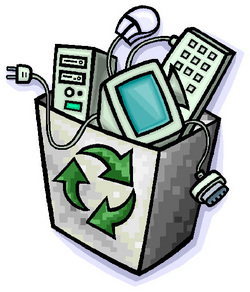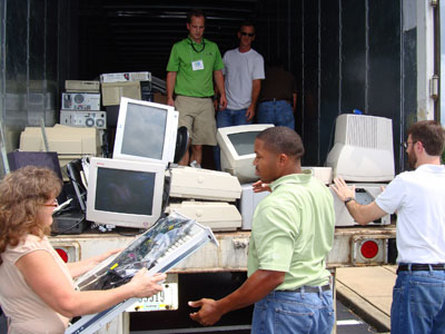WHY RECYCLE RESPONSIBLY?
Throwing out an old computer or cell phone is quite simple, but that isn't just the end of the chain. Where do the electronics we throw out go?
Generally, these items are exported to developing countries such as India and China, where, under highly toxic conditions, the electronics are taken apart by underpaid workers to get to the precious metals inside. According to High Tech Trash:
"On the shores of the Lianjiang River in southern China, a woman squats in front of an open flame. In the pan she holds over the fire is a smoky stew of metal and plastic - a melting circuit board. With unprotected hands she plucks out the microchips. Another woman wields a hammer and cracks the glass of an old computer monitor to remove the copper yoke. The lead-laden glass screen is tossed onto a riverside pile. Nearby, a man sluices a pan of acid over a pile of computer chips, releasing a puff of toxic steam. When the vapor clears a small fleck of gold will emerge. Up and down the riverbanks are enormous hillocks of plastic and metal, the discarded remains of electronic appliances - monitors, keyboards, wires, printers, cartridges, fax machines, motors, disks, and cell phones - that have been exported here for inexpensive, labor-intensive recycling. A bare-legged child stands on one f the mounds, eating an apple. At night, thick black smoke rises from a mountain of burning wires. In the southern Chinese city of Guiyu - one of the places in Asia where thi is primitive recycling takes place - an estimated 80 percent of the city's 150,000 residents are engaged in processing the million or more tons of electronic waste that have been arriving there each year since the mid-1990s."
This waste, or e-waste as it's referred to, is a growing problem in the world. About twenty to fifty metric tons of e-waste is generated by the world each year, the United Nations Environment Programme estimates. Many countries have begun to set up barriers to assist in slowing down this waste problem, but the United States in particular is lagging significantly behind.
Not only are the people being put in unsafe conditions, but the environment is also being damaged. Useless computer parts are being dumped in rivers, polluting water sources and causing villages and towns to lack safe drinking water at a convenient location.
This e-waste problem is not only caused by the disposal of electronics; it's also caused by the over consumption of products. Particularly in America, consumers are told to buy the next new gadget even if their older one is still highly functional. In addition, because of this consumer-based society, electronics are meant to last no longer than 2-4 years, depending on the electronic.
Generally, these items are exported to developing countries such as India and China, where, under highly toxic conditions, the electronics are taken apart by underpaid workers to get to the precious metals inside. According to High Tech Trash:
"On the shores of the Lianjiang River in southern China, a woman squats in front of an open flame. In the pan she holds over the fire is a smoky stew of metal and plastic - a melting circuit board. With unprotected hands she plucks out the microchips. Another woman wields a hammer and cracks the glass of an old computer monitor to remove the copper yoke. The lead-laden glass screen is tossed onto a riverside pile. Nearby, a man sluices a pan of acid over a pile of computer chips, releasing a puff of toxic steam. When the vapor clears a small fleck of gold will emerge. Up and down the riverbanks are enormous hillocks of plastic and metal, the discarded remains of electronic appliances - monitors, keyboards, wires, printers, cartridges, fax machines, motors, disks, and cell phones - that have been exported here for inexpensive, labor-intensive recycling. A bare-legged child stands on one f the mounds, eating an apple. At night, thick black smoke rises from a mountain of burning wires. In the southern Chinese city of Guiyu - one of the places in Asia where thi is primitive recycling takes place - an estimated 80 percent of the city's 150,000 residents are engaged in processing the million or more tons of electronic waste that have been arriving there each year since the mid-1990s."
This waste, or e-waste as it's referred to, is a growing problem in the world. About twenty to fifty metric tons of e-waste is generated by the world each year, the United Nations Environment Programme estimates. Many countries have begun to set up barriers to assist in slowing down this waste problem, but the United States in particular is lagging significantly behind.
Not only are the people being put in unsafe conditions, but the environment is also being damaged. Useless computer parts are being dumped in rivers, polluting water sources and causing villages and towns to lack safe drinking water at a convenient location.
This e-waste problem is not only caused by the disposal of electronics; it's also caused by the over consumption of products. Particularly in America, consumers are told to buy the next new gadget even if their older one is still highly functional. In addition, because of this consumer-based society, electronics are meant to last no longer than 2-4 years, depending on the electronic.
WHAT YOU CAN DO!
- Find out what local companies recycle old electronics
- Make sure said companies to not ship abroad
- Avoid throwing out a perfectly good gadget because a newer version comes out; limit consumption
- Educate those around you about the negative affects of e-waste, and how they themselves can combat it as well
- Hold an electronics drive like the one in the picture below
Facts About E-Waste
- As much as 50–80% of US E-Waste is exported to third world countries where it is generally handled under conditions that endanger the local environment and public health
- Old and new computers alike contain lead, cadmium, and mercury, all hazardous chemicals that end up in the air during the torching process
- Computers and other electronics end up in dumps abroad where workers use bare hands to extract gold from the circuit boards for a small profit
- Workers usually have no other choice but to work in these harsh conditions in order to make very little money, and many of the workers are children
- Many of the workers are working under harsh conditions without any safety gear
- Typical wages for this work are about $2 to $4 a day.


